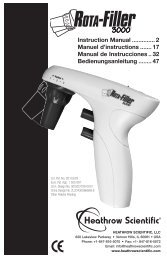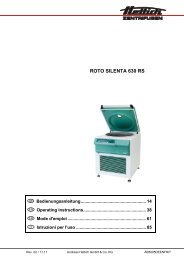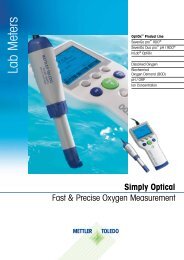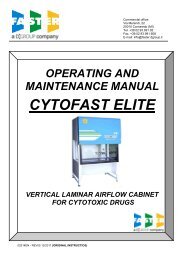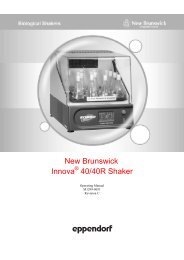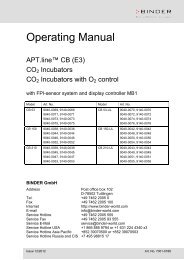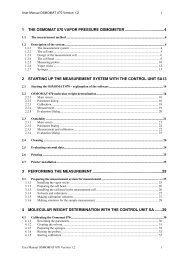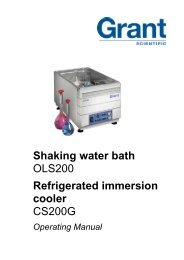Leica RM2125 RTS Manual Microtome - Wolf Laboratories
Leica RM2125 RTS Manual Microtome - Wolf Laboratories
Leica RM2125 RTS Manual Microtome - Wolf Laboratories
You also want an ePaper? Increase the reach of your titles
YUMPU automatically turns print PDFs into web optimized ePapers that Google loves.
<strong>Wolf</strong> <strong>Laboratories</strong> Limited<br />
www.wolflabs.co.uk<br />
Tel: 01759 301142 Fax:01759 301143 sales@wolflabs.co.uk<br />
Use the above details to contact us if this literature doesn't answer all your<br />
questions.<br />
Pricing on any accessories shown can be found by keying the part number<br />
into the search box on our website.
The Essential <strong>Microtome</strong><br />
<strong>Leica</strong> <strong>RM2125</strong> <strong>RTS</strong> <strong>Manual</strong> <strong>Microtome</strong><br />
Cut the high-quality sections that accurate diagnosis depends on. The<br />
<strong>Leica</strong> <strong>RM2125</strong> <strong>RTS</strong> manual microtome has the essential features you<br />
need for safer economic sectioning and optimized workflows.
Quality is essential<br />
When cutting sections from patient tissue, you want every section to count. The <strong>Leica</strong> <strong>RM2125</strong><br />
<strong>RTS</strong> utilizes the essential elements of proven <strong>Leica</strong> Microsystems’ technology to deliver<br />
high-quality sectioning in an economical manual package.<br />
• Accuracy – precise feed mechanism means precise sections<br />
• Stability – PowerBase ensures stable operation for vibration-free sectioning<br />
• Security – advanced knife holder and specimen clamp securely align cutting edge to block<br />
Safety is essential<br />
Because you don’t want to compromise on safety, the <strong>Leica</strong> <strong>RM2125</strong> <strong>RTS</strong> doesn’t either. By<br />
combining the essential elements of intuitive operation and advanced safety features, the <strong>Leica</strong><br />
<strong>RM2125</strong> <strong>RTS</strong> helps microtomists work more safely throughout each shift.<br />
• Only the essentials – with only the most important functions, complexity is reduced and<br />
operation simplified<br />
• For the user – user-selectable coarse feed wheel turn direction and retraction functions so<br />
the microtome works for each individual user<br />
• Added safety by design – a smooth running hand wheel, built-in safety guards and a<br />
rounded instrument shape with arm rests for fatigue-free sectioning<br />
Productivity is essential<br />
With no time to waste, efficient sectioning is critical for overall laboratory productivity. The manual<br />
<strong>Leica</strong> <strong>RM2125</strong> <strong>RTS</strong> has the essential features for highly productive sectioning.<br />
• Efficient set up – a quick-exchange specimen clamp and an 8° orientation system for the<br />
object head allow rapid set up for any block<br />
• Efficient operation – two trim steps (50 µm coarse, 10 µm fine) mean fast trimming so you<br />
can produce sections sooner<br />
• Efficient use of space – store essential tools and accessories on top of the microtome so<br />
they are off the bench, and easy to access<br />
<strong>Leica</strong> <strong>RM2125</strong> <strong>RTS</strong> Technical Specifications<br />
General Information<br />
Section thickness setting range: 0.5 – 60 µm<br />
Total horizontal specimen feed: 25 mm<br />
Vertical specimen stroke: 59 mm<br />
Specimen retraction: ON/OFF<br />
Coarse feed wheel turn direction: User selectable<br />
Specimen orientation: XY – 8°<br />
Trimming thickness: 10 µm, 50 µm<br />
Dimensions<br />
Dimensions (W x D x H): 438 mm x 472 mm x 265 mm,17.24” x 18.58” x 10.43”<br />
Weight: (without accessories): 29 kg, 63.9 lbs<br />
Technical specifications subject to change.<br />
The <strong>Leica</strong> <strong>RM2125</strong> <strong>RTS</strong> has been designed and manufactured in compliance with IEC requirements.<br />
<strong>Leica</strong> <strong>RM2125</strong> <strong>RTS</strong> with PowerBase stability<br />
Quick-exchange specimen clamp<br />
8° orientation system<br />
Two trim steps for efficient operation
<strong>Leica</strong> RM2235<br />
The <strong>Manual</strong> Rotary <strong>Microtome</strong> For Outstanding Durability,<br />
Precision and Comfort
As Durable as Ever, Enhanced Precision and Comfort<br />
Like Never Before: The New <strong>Leica</strong> RM2235<br />
Durability is essential in a manual microtome and the<br />
<strong>Leica</strong> RM2235 can stand up to the workload requirements<br />
of even the busiest laboratories. The enhanced precision<br />
of the new accessories will add convenience to block to<br />
knife approach as well as specimen orientation.<br />
The new <strong>Leica</strong> RM2235 manual microtome provides<br />
unique user-friendliness, achieved through numerous new<br />
features, most of them patented, which have never before<br />
been offered in this class of microtome. The <strong>Leica</strong> RM2235<br />
combines proven technology with well thought-out ergonomic<br />
details and the highest safety standards.<br />
Working in comfort is not a luxury but a necessity. A re-<br />
Program<br />
laxed, ergonomic working posture is a basic prerequisite<br />
for the high levels of speed, precision, and efficiency<br />
required in modern laboratories. Day after day, the new<br />
Histotechnology<br />
<strong>Leica</strong> RM2235 provides comfortable functionality without<br />
compromise. The RM2235 is the instrument of choice for<br />
University<br />
all clinical histology and histopathology institutions where<br />
manual microtomes are preferred over motorized units. Indiana
The New Approach to <strong>Manual</strong> Sectioning<br />
■ Fatigue-free operation<br />
Ergonomics and user comfort were<br />
prime considerations for the location<br />
of the coarse feed wheel, which is<br />
positioned close to the operator.<br />
The direction of the handwheel rotation<br />
to best suit your sectioning style<br />
can be specified at the time an order<br />
is placed. The mechanical trimming<br />
function, conveniently placed next<br />
to the coarse feed wheel, eliminates<br />
the need to turn the coarse feed<br />
wheel during trimming.<br />
■ Spacious, magnetized section<br />
waste tray<br />
The spacious section waste tray<br />
reliably collects sectioning debris.<br />
It is safely held in position by<br />
magnets, yet is easily removable for<br />
emptying and cleaning.<br />
<strong>Leica</strong> Design by Werner Hölbl<br />
■ Safety during sectioning<br />
Safety is ensured by the integrated,<br />
red finger protection guard of the<br />
knife holder E that uniquely shields<br />
the blade edge. When used correctly<br />
the integrated finger protection guard<br />
rules out potential injuries because<br />
it can even remain on the blade edge<br />
during sectioning.<br />
* not supplied with basic instrument<br />
■ Convenient storage area<br />
An integrated storage tray* ensures<br />
that ancillary tools are on hand at all<br />
times. Alternatively a cooling plate with<br />
thermo element can be used for cold<br />
storage of specimen blocks either on<br />
top or on either side of the microtome.
■ Ergonomics and user safety<br />
The smooth-running safety handwheel<br />
has an ergonomically shaped handle.<br />
A handwheel locking device for onethumb<br />
operation locks the specimen<br />
head in the uppermost position, which<br />
is ideal for changing the specimen<br />
and/or blade. A second locking mechanism<br />
on the microtome base allows<br />
the object head to be locked in any<br />
position.<br />
■ The patented force balancing<br />
system<br />
The RM2235 handwheel runs exceptionally<br />
smoothly because it has no<br />
balancing weight. Instead, the patented<br />
force balancing system uses<br />
a spring to compensate the forces<br />
generated during sectioning. The<br />
result: effortless operation and uniform<br />
handwheel rotation – producing<br />
much better sectioning results.<br />
<strong>Leica</strong>-patented:<br />
Spring-based force<br />
balancing system<br />
Conventional:<br />
Handwheel with<br />
balancing weight<br />
■ Fast sectioning without specimen orientation<br />
For applications where specimen orientation is not<br />
needed, a non-orienting fixture for specimen clamps<br />
is available as an optional accessory. The Super<br />
Mega cassette can clamp specimens up to a size of<br />
46 x 66 x 10 mm (W x H x D).<br />
■ Precision specimen orientation with<br />
clear zero reference point<br />
This novel orientation mechanism sets new standards<br />
of precision and is very easy to operate. Calibrated<br />
controls make it easy to adjust a specimen to an exact<br />
zero position indicated by red pins or a measurable<br />
variable on the x/y axis for re-cuts.<br />
■ Lateral knife holder adjustment<br />
The entire width of the microtome blade can be used<br />
without having to release the blade clamping mechanism.<br />
Using the entire knife edge is cost effective, especially<br />
in laboratories with high specimen throughput.<br />
Three predefined stop positions (left, center, right)<br />
correspond to the width of a standard histology cassette.<br />
■ A special accessory:<br />
Chilled universal cassette clamp (UCC)<br />
The UCC is kept cold by placing ice cubes or dry ice in<br />
a special compartment, which ensures that specimen<br />
blocks remain at cold temperatures throughout the<br />
entire sectioning process.<br />
Well thought-out and proven:<br />
Knife holder base<br />
universal knife holder base fits virtually all <strong>Leica</strong> knife<br />
holder systems.<br />
Universal cassette clamp for single-hand operation<br />
definitely THE easiest way to clamp/remove specimens.<br />
Optimized microtome base plate<br />
provides maximum rigidity – thanks to the latest technology<br />
and new lightweight materials.<br />
One-piece housing<br />
made from specially resistant plastic, without any edges<br />
where debris could accumulate, which reduces cleaning<br />
to a minimum.<br />
Fewer clamping levers<br />
makes the <strong>Leica</strong> RM2235 easier to use by providing improved<br />
access to the cutting area.
Technical Specifications<br />
Section thickness<br />
Setting range: 1 – 60 µm<br />
Setting values: 1 – 10 µm in 1 µm increments<br />
10 – 20 µm in 2 µm increments<br />
20 – 60 µm in 5 µm increments<br />
Section thickness indication: viewing window<br />
Coarse feed: manual via coarse feed wheel<br />
Trim settings: 10, 30 µm<br />
Total horizontal specimen feed: approx. 30 mm<br />
Vertical stroke: 70 mm<br />
Specimen retraction: approx. 60 µm, can be deactivated<br />
The <strong>Leica</strong> RM2235 features at a glance:<br />
Precision specimen orientation with zero point reference<br />
Compact, ergonomic overall design<br />
User safety integrated into all aspects of the instrument<br />
Ergonomically located coarse feed wheel for<br />
fatigue-free operation<br />
Extremely smooth-running handwheel due to<br />
patented force compensation system<br />
Two safety locking mechanisms on the handwheel<br />
Precise knife holder lateral adjustment ensures<br />
that the entire width of the blade edge can be used<br />
Cooling plate (optional)<br />
Maximum specimen size (W x H x D): 50 x 66 x 30 mm<br />
Specimen orientation: horizontal: 8°<br />
vertical: 8°<br />
Dimensions<br />
Width (including handwheel): 413 mm (16.26 in.)<br />
Depth (including section waste tray): 618 mm (24.33 in.)<br />
Height (with storage tray installed on housing): 305 mm (12.01 in.)<br />
Weight (without accessories): approx. 34 kg, 75 lbs<br />
A wide range of accessories is available upon request.<br />
Technical specifications are subject to change without notice.<br />
Certifications: CE, c-CSA-us<br />
Up-to-date development, production and quality control procedures are certified under DIN<br />
EN ISO 9001 to ensure highest quality and reliability.<br />
Single-handed operation specimen clamps<br />
Universal knife holder base for different knife holders<br />
Disposable blade holder with integrated safety<br />
finger protection guard<br />
Spacious magnetized section waste tray<br />
One-piece, easy-to-clean housing
<strong>Leica</strong> RM2245<br />
The <strong>Manual</strong> <strong>Microtome</strong> with High-Precision Motorized Specimen Feed
The New <strong>Leica</strong> RM2245 – Efficiency<br />
Goes Hand in Hand with Comfort<br />
The new <strong>Leica</strong> RM2245 semi-motorized rotary microtome<br />
represents the perfect combination of economic efficiency<br />
and user comfort. It is the instrument of choice for clinical<br />
histology and histopathology applications, as well as for<br />
industrial quality assurance.<br />
The <strong>Leica</strong> RM2245 is designed to meet the many requirements<br />
of modern laboratories. This task is fulfilled without<br />
compromise by combining proven technology and exemplary<br />
safety standards with functionality and ergonomic<br />
design.<br />
<strong>Manual</strong> sectioning is enhanced by the high-precision motorized<br />
specimen feed, which results in efficient operation<br />
with maximum section reproducibility. Operator fatigue is<br />
reduced through the use of the patented spring system,<br />
which eliminates the need for a heavy counter balance<br />
weight in the handwheel. Enhanced user comfort results<br />
in maximum workplace efficiency and high specimen<br />
throughput.<br />
With the <strong>Leica</strong> RM2245 there is a choice between the<br />
conventional manual sectioning method of full handwheel<br />
rotation and the “rocking mode”. In rocking mode, the<br />
handwheel is only turned back and forth over a short distance.<br />
Every change in rotation direction is automatically<br />
translated into a specimen feed or retraction movement.<br />
Indiana University Histotechnology Program
The Useful Details Show a Great Design Concept<br />
■ Safety during sectioning<br />
Safety is ensured by the integrated,<br />
red finger protection guard of the<br />
knife holder E that uniquely shields<br />
the blade edge. When used correctly<br />
the integrated finger protection<br />
guard rules out potential injuries<br />
because it can even remain on the<br />
blade edge during sectioning.<br />
■ Comfortable operation<br />
All functions are controlled via a compact,<br />
space-saving control panel with<br />
areas in contrasting colors and touchsensitive<br />
buttons that allow ‘blind<br />
operation‘. Panel inclination is adjustable,<br />
and the panel can be positioned<br />
either on the left or right side of the<br />
instrument.<br />
<strong>Leica</strong> Design by Werner Hölbl<br />
■ Unobstructed work area<br />
To provide improved access to the<br />
cutting area, several clamping levers<br />
that are not routinely used have<br />
been replaced by hidden clamping<br />
devices without compromising standard<br />
setting options.<br />
■ Convenient storage area<br />
An integrated storage tray* ensures<br />
that ancillary tools are on hand at all<br />
times. Alternatively a cooling plate<br />
with thermo element can be used<br />
for cold storage of specimen blocks<br />
either on top or on either side of the<br />
microtome.<br />
* not supplied with basic instrument
■ Easy to clean<br />
Due to the rounded shape of the<br />
<strong>Leica</strong> RM2245’s one piece housing,<br />
section waste is easily removed.<br />
The integrated slot cover prevents<br />
debris from entering the internal<br />
mechanisms of the microtome.<br />
■ Spacious, magnetized section<br />
waste tray<br />
The spacious section waste tray reliably<br />
collects sectioning debris. It is<br />
safely held in position by magnets,<br />
yet is easily removable for emptying<br />
and cleaning.<br />
■ Ergonomics and user safety<br />
The smooth-running safety handwheel<br />
has an ergonomically shaped<br />
handle. A hand-wheel locking device<br />
for one-thumb operation locks the<br />
specimen head in the uppermost<br />
position, which is ideal for changing<br />
the specimen and/or blade. A second<br />
locking mechanism on the microtome<br />
base allows locking the object head<br />
in any position.<br />
■ Stability<br />
Maximum rigidity and stability are<br />
provided by the optimized microtome<br />
base plate.<br />
■ Precision specimen orientation with<br />
clear zero reference point<br />
This novel orientation mechanism sets new standards of precision<br />
and is very easy to operate. An important detail: Calibrated<br />
controls make it easy to adjust a specimen to an exact zero<br />
position indicated by red pins or a measurable variable on the<br />
x/y axis for re-cuts.<br />
■ Lateral knife holder adjustment<br />
The entire width of the microtome blade can be used without<br />
having to release the blade clamping mechanism. Using the<br />
entire knife edge saves costs, especially in laboratories with<br />
high specimen throughput. Three predefined stop positions<br />
(left, center, right) correspond to the width of a standard histology<br />
cassette.<br />
Well thought-out and proven<br />
The <strong>Leica</strong>-patented Force Compensation System<br />
for extremely smooth manual handwheel operation.<br />
The Precision Micrometer Feed System<br />
from 0.5 µm to 100 µm in sectioning mode and 1 µm to<br />
600 µm in trimming mode via stepper motor.<br />
The <strong>Leica</strong> Control Panel Concept<br />
separate and intuitive control panel for instrument<br />
settings and communication display integrated in the<br />
instrument housing at eye level.<br />
Accessories<br />
a wide range of blade or knife holders and specimen<br />
holders is available for a variety of applications.
Technical Specifications<br />
Section thickness<br />
Setting range: 0.5 – 100 µm<br />
Setting values: from 0.5 – 5 µm in 0.5 µm-increments<br />
from 5 – 20 µm in 1 µm-increments<br />
from 20 – 60 µm in 5 µm-increments<br />
from 60 –100 µm in 10 µm-increments<br />
Trimming section<br />
thickness setting range: 1 – 600 µm<br />
Setting values: from 1 – 10 µm in 1 µm-increments<br />
from 10 – 20 µm in 2 µm-increments<br />
from 20 – 50 µm in 5 µm-increments<br />
from 50 – 100 µm in 10 µm-increments<br />
from 100 – 600 µm in 50 µm-increments<br />
Object feed: 28 mm ±1 mm, feed motion<br />
via step motor<br />
Vertical specimen stroke: 70 mm<br />
Sectioning modes: 2 manual modes (conventional full<br />
handwheel rotation and rocking mode)<br />
Specimen retraction: 5 – 100 µm in 5 µm-increments,<br />
can be turned off<br />
The <strong>Leica</strong> RM2245 features at a glance:<br />
Precision specimen orientation with zero point reference<br />
Compact, ergonomic overall design<br />
Section thickness totalizer and section counter<br />
Easy alternation between trimming and sectioning function<br />
Two motorized forward and backward specimen<br />
coarse feed speeds<br />
Programmable specimen retraction<br />
Low-maintenance cross roller bearings<br />
Single-handed operation universal cassette clamp<br />
Completely new knife holder concept for disposable<br />
blades, with finger guard in contrasting color<br />
Precise knife holder lateral movement<br />
User safety integrated into overall design<br />
Smooth-running handwheel with integrated<br />
quick-lock mechanism<br />
Electric coarse feed: 300 µm/s and 900 µm/s<br />
Maximum specimen size (L x H x W): 50 x 60 x 40 mm<br />
Specimen orientation: horizontal: 8°, vertical: 8°<br />
Nominal supply voltages: 100/120/230/240 V AC ±10%<br />
Nominal frequency: 50/60 Hz<br />
Power draw: 70 VA<br />
Dimensions basic instrument<br />
Width (including handwheel): 413 mm<br />
Depth (including waste tray): 618 mm<br />
Height (with storage area on cover): 305 mm<br />
Weight (without accessories): approx. 37 kg (87 lbs)<br />
Dimensions control panel<br />
W x D x H: 94 x 164 x 50 mm<br />
Weight: approx. 0.450 kg (1 lb)<br />
Wide range of accessories on request.<br />
Technical specification subject to change.<br />
Certificates: CE, c-CSA-us<br />
Up-to-date development, production and quality control procedures certified<br />
under DIN EN ISO 9001 to ensure highest quality and reliability.<br />
Ergonomically optimized handwheel handle<br />
Communication display integrated in instrument housing<br />
Enclosed micrometer mechanism<br />
Spacious magnetized section waste tray<br />
Intuitive control panel<br />
Wide range of accessories
<strong>Leica</strong> RM2255<br />
Rotary <strong>Microtome</strong> for high-Performance Motorized and<br />
<strong>Manual</strong> Sectioning
The New <strong>Leica</strong> RM2255 Rotary <strong>Microtome</strong><br />
High-performance is an important factor when considering<br />
the quality of rotary microtomes. A modern microtome<br />
must also offer safety, ergonomy, efficiency, and economy.<br />
With this in mind, <strong>Leica</strong> Microsystems designs and<br />
manufactures microtomes that set new standards in<br />
today’s laboratory.<br />
The new fully automated <strong>Leica</strong> RM2255 microtome embodies<br />
the latest technological innovations in microtomy and per-<br />
fectly harmonizes practical features with an ergonomic<br />
design and user safety. Its two-in-one design concept,<br />
which allows motorized as well as manual sectioning,<br />
provides reproducible, quality sections.<br />
The <strong>Leica</strong> RM2255 is a blend of proven high-performance,<br />
precision microtome technology with all the added bene-<br />
fits customers expect from the market leader in microtomy.<br />
The attention to detail in this new microtome, part of the<br />
<strong>Leica</strong> RM2200 family of quality microtomes, represents<br />
another step in the advancement of innovative, user-<br />
oriented microtomes.
■ Control panel<br />
with colored, raised keys, allows<br />
‘touch’ control so all of the operator’s<br />
attention can be fully focused<br />
on sectioning and section retrieval.<br />
The panel has adjustable inclination,<br />
a very small footprint, and can be<br />
positioned to the left or right of the<br />
instrument.<br />
<strong>Leica</strong> Design by Werner Hölbl<br />
■ Knife holder E<br />
is our most popular knife holder and<br />
accepts either high or low profile<br />
disposable blades. For enhanced<br />
safety, an integrated finger guard<br />
covers the entire blade, even during<br />
sectioning.<br />
High-Performance Motorized a<br />
■ Fewer clamping levers<br />
permit unencumbered access to the<br />
cutting area. The locking pins can<br />
also be moved from one side to the<br />
other and the levers can be repositioned<br />
after locking to further clear<br />
the work area.<br />
■ Ample storage space:<br />
on an integrated storage tray provides<br />
plenty of space for your ancillary tools.<br />
For cool storage of specimen blocks<br />
right on the microtome, we recommend<br />
the optional cooling tray with unique<br />
cooling blocks.<br />
■<br />
co<br />
an<br />
pra<br />
Th<br />
sp<br />
co<br />
fas<br />
■<br />
c<br />
p<br />
tr<br />
m<br />
th<br />
c
nd <strong>Manual</strong> Sectioning Sets New Standards!<br />
ne-piece housing,<br />
bines ergonomics, aesthetics<br />
ease-of-use while meeting the<br />
ctical requirements of the lab.<br />
one-piece housing, made from<br />
cially resistant plastic, allows<br />
fortable access to controls and<br />
t and easy cleaning.<br />
Spacious, integrated section<br />
waste tray<br />
onveniently prevents scattering of<br />
araffin debris. The section waste<br />
ay is securely held in position by a<br />
agnet, but is easy to remove from<br />
e instrument for emptying and<br />
leaning.<br />
■ Safe, smooth-running handwheel<br />
features a new ergonomic handle, a<br />
traditional lock that locks anywhere<br />
in the rotation, and a new easy<br />
access, quick-lock device to lock the<br />
specimen in the uppermost position.<br />
For motorized sectioning, the handwheel<br />
handle can be centered.<br />
Safety is <strong>Leica</strong>’s number one priority.<br />
■ Stable microtome base plate<br />
was designed using the latest technology<br />
and materials to produce a<br />
robust, stable, yet lightweight support<br />
for the precision microtome<br />
mechanisms.<br />
■ Precise specimen orientation<br />
sets new standards of precision in rotary microtomes. With the<br />
use of calibrated controls and visual aids, it is simple to adjust<br />
the specimen to an exact zero point or in measurable variables<br />
of up to 8° along the x-y axis.<br />
■ Lateral knife holder adjustment<br />
allows the use of the entire length of the blade without having to<br />
change the tension setting. Three predefined stop positions (left,<br />
center, right) that correspond to the width of a standard histology<br />
cassette may be used if desired.<br />
Proven Technology:<br />
<strong>Leica</strong>’s patented gravitational force<br />
compensation system<br />
makes rotating the handwheel extremely smooth and<br />
light, which is especially beneficial during manual<br />
sectioning applications.<br />
Precise micrometer feed system<br />
permits precision sectioning from 0.5 µm to 100 µm<br />
via the use of a stepper motor and low-maintenance,<br />
cross-roller bearings.<br />
Powerful sectioning motor<br />
is rugged enough for sectioning most hard specimens<br />
without producing sectioning artifacts.<br />
Specially designed electronics system<br />
allows flexible operation of the instrument while<br />
providing precision control over the specimen<br />
advance and cutting speeds.<br />
Universal knife holder base<br />
is compatible with all routine <strong>Leica</strong> RM2200 series<br />
microtome knife holder systems that require a base.<br />
One-hand operated universal cassette clamp<br />
is definitely THE easiest way to clamp and remove<br />
specimens.
Technical Specifications<br />
Section thickness:<br />
Section thickness setting range: 0,5 – 100 µm<br />
Setting values: from 0,5 µm – 5 µm in 0,5 µm-increments<br />
from 5 – 20 µm in 1 µm-increments<br />
from 20 – 60 µm in 5 µm-increments<br />
from 60 –100 µm in 10 µm-increments<br />
Trimming section<br />
thickness setting range: 1 – 600 µm<br />
Setting values: from 1 – 10 µm in 1 µm-increments<br />
from 10 – 20 µm in 2 µm-increments<br />
from 20 – 50 µm in 5 µm-increments<br />
from 50 – 100 µm in 10 µm-increments<br />
from 100 – 600 µm in 50 µm-increments<br />
Object feed: 28 mm ±1 mm, feed motion via<br />
step motor<br />
Vertical specimen stroke: 70 mm<br />
Sectioning modes: 4<br />
Specimen retraction:<br />
in manual operation: 5 – 100 µm in 5 µm-increments,<br />
can be turned off<br />
in motorized operation: varying with the sectioning<br />
speed, can be turned off<br />
Electric coarse feed: 300 µm/s und 900 µm/s<br />
Sectioning speed: 0,5 – 420 mm/s ± 10%<br />
The <strong>Leica</strong> RM2255 Features at a Glance:<br />
Compact, ergonomic design<br />
Ergonomically designed handwheel handle<br />
Smooth-running handwheel with integrated quick-lock<br />
mechanism for safety<br />
Enclosed micrometer feed mechanism<br />
Low-maintenance cross-roller bearings<br />
Two forward and backward coarse feed speeds<br />
Alternate trimming and sectioning modes, as indicated<br />
on the display<br />
Speed control through the cutting window for enhanced<br />
efficiency<br />
Automatic, variable specimen retraction, depending on<br />
sectioning speed<br />
Section thickness totalizer and section counter<br />
Intuitive control panel<br />
Integrated communication display<br />
Precise specimen orientation with zero point reference<br />
Maximum specimen size (L x H x W): 50 x 60 x 40 mm<br />
Specimen orientation: horizontal: 8°, vertical: 8°<br />
Nominal supply voltages: 100 / 120 / 230 / 240 V AC ±10%<br />
Nominal frequency: 50/60 Hz<br />
Power draw:<br />
Dimensions basic instrument<br />
340 VA<br />
Width (including hand wheel) 413 mm<br />
Depth (including waste tray) 618 mm<br />
Height (with storage area on cover): 305 mm<br />
Weight (without accessories)<br />
Dimensions control panel<br />
approx. 37 kg, approx. 81 lbs<br />
WxDxH: 121 x 166 x 50 mm<br />
Weight: approx. 0.66 kg, approx. 1.45 lbs<br />
Wide range of accessories on request.<br />
Technical specification subject to change.<br />
Certificates: CE, c-CSA-us<br />
Up-to-date development, production and quality control procedures certified<br />
under DIN EN ISO 9001 ensure highest quality and reliability.<br />
One-hand operated universal cassette clamp<br />
Completely new knife holder design with red colored<br />
knife guard<br />
Precise lateral knife holder adjustment with click stop<br />
settings<br />
Spacious and easy-to-clean section waste tray<br />
Wide range of accessories
<strong>Leica</strong> RM2265<br />
The Fully Motorized, Programmable Rotary <strong>Microtome</strong>
When it comes to selecting a microtome, many factors<br />
have to be taken into consideration and it's hard to decide<br />
which factor is the most important: reliability, innovative<br />
technology, efficiency, ergonomics or safety. <strong>Leica</strong><br />
believes that each of these aspects is equally essential for<br />
the most crucial requirement a modern microtome has to<br />
meet: Versatility.<br />
<strong>Leica</strong> Microsystems offers a microtome that can satisfy<br />
all of your laboratory’s requirements: the fully motorized,<br />
versatile <strong>Leica</strong> RM2265 rotary microtome. It is the top-ofthe-line<br />
product in the <strong>Leica</strong> RM2200 rotary microtome<br />
series and is designed to produce superior sections of a<br />
multitude of specimen types with ease. Its outstanding<br />
technology allows it to be used for semi-thin to thick sectioning<br />
of soft or hard specimens; routine as well as special<br />
biomedical research applications; and industrial quality<br />
assurance and materials research applications.<br />
Whether your instrument requirements are dedicated to a<br />
single discipline or demand the versatility to perform in multiple<br />
disciplines, the <strong>Leica</strong> RM2265 provides the perfect<br />
solution for achieving constant, high-performance workflow<br />
in your laboratory. And instead of compromising one<br />
advantage for another, the <strong>Leica</strong> RM2265 allows you to benefit<br />
from all of the latest state-of-the-art-technology in modern<br />
microtomy.<br />
With the <strong>Leica</strong> RM2265, a total of six sectioning modes are<br />
is available. In motorized operation there are four operating<br />
mode selections: continuous, single or step stroke, and<br />
program mode. In manual operation it is possible to use<br />
the conventional method of completing a full handwheel<br />
rotation or the intuitive “rock” mode. When the handwheel<br />
is moved back and forth over a small distance, each<br />
change in direction is electronically detected and automatically<br />
converted into an advance or retraction movement<br />
of the specimen arm.<br />
Versatility Without Compromise:<br />
The <strong>Leica</strong> RM2265
A Sophisticated Approach to Versatility<br />
■ Control panel operation<br />
The automated functions of the<br />
microtome are controlled via a separate,<br />
compact control panel. Controls<br />
for specific functions are<br />
grouped together and the most used<br />
areas contain contrasting colors<br />
and touch-sensitive buttons that<br />
allow “blind operation”. Panel inclination<br />
is adjustable, and the panel<br />
can be positioned either on the left<br />
or right side of the instrument.<br />
<strong>Leica</strong> Design by Werner Hölbl<br />
■ Utmost versatility for many<br />
special requirements<br />
A wide choice of optional accessories<br />
includes a microscope carrier<br />
with two fiber optic light guides for<br />
the optimal illumination of the knife<br />
and specimen.<br />
■ Unobstructed work area<br />
To provide improved access to the<br />
cutting area, hidden clamping<br />
mechanisms have replaced several<br />
clamping levers that are not routinely<br />
used, without compromising<br />
the standard setting options.<br />
■ Easy-to-clean<br />
Due to the rounded sha<br />
<strong>Leica</strong> RM2265’s one-piece<br />
section waste is easily<br />
The integrated slot cover<br />
debris from entering th<br />
mechanisms of the micro
pe of the<br />
housing,<br />
removed.<br />
prevents<br />
internal<br />
tome.<br />
■ Ergonomics and user safety<br />
The smooth-running safety handwheel<br />
has an ergonomically<br />
shaped handle. A handwheel locking<br />
device for one-thumb operation<br />
locks the specimen arm in the<br />
uppermost position, which is ideal<br />
for changing the specimen and/or<br />
blade. A second locking mechanism<br />
on the microtome base allows<br />
locking the object head in any position.<br />
During motorized sectioning,<br />
activation of the emergency stop<br />
button located on the instrument<br />
will immediately halt the movement<br />
of the specimen arm.<br />
■ Stability<br />
The optimized microtome base<br />
plate provides maximum rigidity<br />
and stability.<br />
■ Magnetized section waste tray<br />
The section waste tray is safely held<br />
in position by magnets, yet is easily<br />
removable for emptying and cleaning.<br />
If needed, a larger waste tray is<br />
optionally available for applications<br />
with a high amount of sectioning<br />
debris.<br />
■ Precise specimen orientation with clear zero<br />
reference point<br />
This novel orientation mechanism sets new standards<br />
of precision. Guided by visual indicators, the<br />
adjustment of calibrated controls makes it easy to<br />
orient a specimen to an exact zero position or to a<br />
measurable variable on the x/y axis.<br />
■ Universal knife holder base<br />
The knife holder base is suitable for holding various<br />
disposable blade or reusable knife holders, making<br />
it possible to section a variety of specimen types.<br />
■ <strong>Leica</strong> LN22 freezing device<br />
The low temperature sectioning system has been<br />
specifically designed for use with the <strong>Leica</strong> RM2265<br />
microtome. Even the most demanding specimen can<br />
be precisely sectioned in a thickness range from<br />
0.25 µm to 100 µm at temperatures down to –150 °C.<br />
Well thought-out and proven<br />
<strong>Leica</strong>-Patented Force Compensation System<br />
provides extremely smooth manual handwheel operation.<br />
Precision Micrometer Feed System<br />
provides semi-thin to thick sectioning via stepper motor from<br />
0.25 µm to 100 µm in sectioning mode and 1 µm – 600 µm in<br />
trimming mode.<br />
Integrated, Intuitive Display<br />
conveniently displays instrument settings and performance<br />
information at eye level.<br />
Wide Range of Accessories<br />
tailors the <strong>Leica</strong> RM2265 to meet individual needs and optimizes<br />
the sectioning performance of any specimen, e.g., a<br />
wide assortment of holders for any type of knife or disposable<br />
blade and specimens of every shape; stereomicroscope<br />
carrier; widefield magnifier; or <strong>Leica</strong> LN22 liquid<br />
nitrogen freezing device.
<strong>Leica</strong> RM2265 – Technical Specifications<br />
Section thickness:<br />
Section thickness<br />
setting range: 0.25 µm – 100 µm<br />
Setting values: 0.25 µm<br />
from 0.5 – 5.0 µm in 0.5 µm increments<br />
from 5 – 20 µm in 1 µm increments<br />
from 20 – 60 µm in 5 µm increments<br />
from 60 – 100 µm in 10 µm increments<br />
Trimming section thickness<br />
setting range: 1 – 600 µm<br />
Setting values: from 1 – 10 µm in 1 µm increments<br />
from 10 – 20 µm in 2 µm increments<br />
from 20 – 50 µm in 5 µm increments<br />
from 50 – 100 µm in 10 µm increments<br />
from 100 – 600 µm in 50 µm increments<br />
Specimen retraction:<br />
<strong>Manual</strong> Operation programmable from 5 – 100 µm in 5 µm<br />
increments; can be turned off<br />
Motorized Operation: varying with the sectioning speed;<br />
can be turned off<br />
Electronic coarse feed: 300 µm/s or 900 µm/s<br />
Sectioning speed range: 0.5 – 420 mm/s<br />
Horizontal specimen feed: approx. 30 mm<br />
The <strong>Leica</strong> RM2265 features at a glance:<br />
Compact, ergonomic overall design<br />
User safety integrated into the microtome and<br />
accessories<br />
Intuitive control panel<br />
Automatic, variable specimen retraction, depending<br />
on sectioning speed<br />
Two motorized forward and backward specimen<br />
coarse feed speeds<br />
Two separate programs for trimming and<br />
sectioning mode<br />
Speed control through the cutting window for<br />
enhanced efficiency<br />
Programmable vertical object head stop position,<br />
especially ideal for the LN22<br />
Communication display integrated in instrument housing<br />
Section thickness setting of 0.25 µm to 100 µm<br />
Section thickness totalizer and section counter<br />
Vertical specimen stroke: 70 mm<br />
Sectioning modes: 6 total<br />
2 manual modes<br />
(regular and rocking mode)<br />
4 motorized modes<br />
(continuous, single or step stroke,<br />
and program mode)<br />
Maximum specimen size (L x H x W): 50 x 60 x 40 mm (1.96 x 2.36 x 1.57 in.)<br />
Specimen orientation: horizontal: 8°, vertical: 8°<br />
Power draw max: 340 VA<br />
Nominal supply voltages: 100 V / 120 V / 230 V / 240 V<br />
Nominal frequency: 50/60 Hz<br />
Dimensions basic instrument<br />
(L x W x H): 563 x 413 x 305 mm (22.16 x 16.25 x 12 in.)<br />
(without magnifier or microscope<br />
carrier)<br />
Weight (without accessories) approx. 37 kg (approx. 81 lbs)<br />
Dimensions control panel<br />
(W x D x H): 121 x 166 x 50 mm (4.76 x 6.53 x 1.96 in.)<br />
Weight: approx. 0.68 kg (approx. 1.45 lbs)<br />
Wide range of accessories on request. Technical specification subject to change.<br />
Certificates: CE, c-CSA-us<br />
Up-to-date development, production, and quality control procedures certified under<br />
DIN EN ISO 9001 to ensure the highest quality and reliability.<br />
Smooth-running handwheel with integrated<br />
quick-lock mechanism<br />
Ergonomically optimized handwheel handle<br />
Low-maintenance cross roller bearings<br />
Enclosed micrometer mechanism<br />
Precision specimen orientation with zero point<br />
reference<br />
Magnetized section waste tray<br />
Wide range of accessories for special applications



